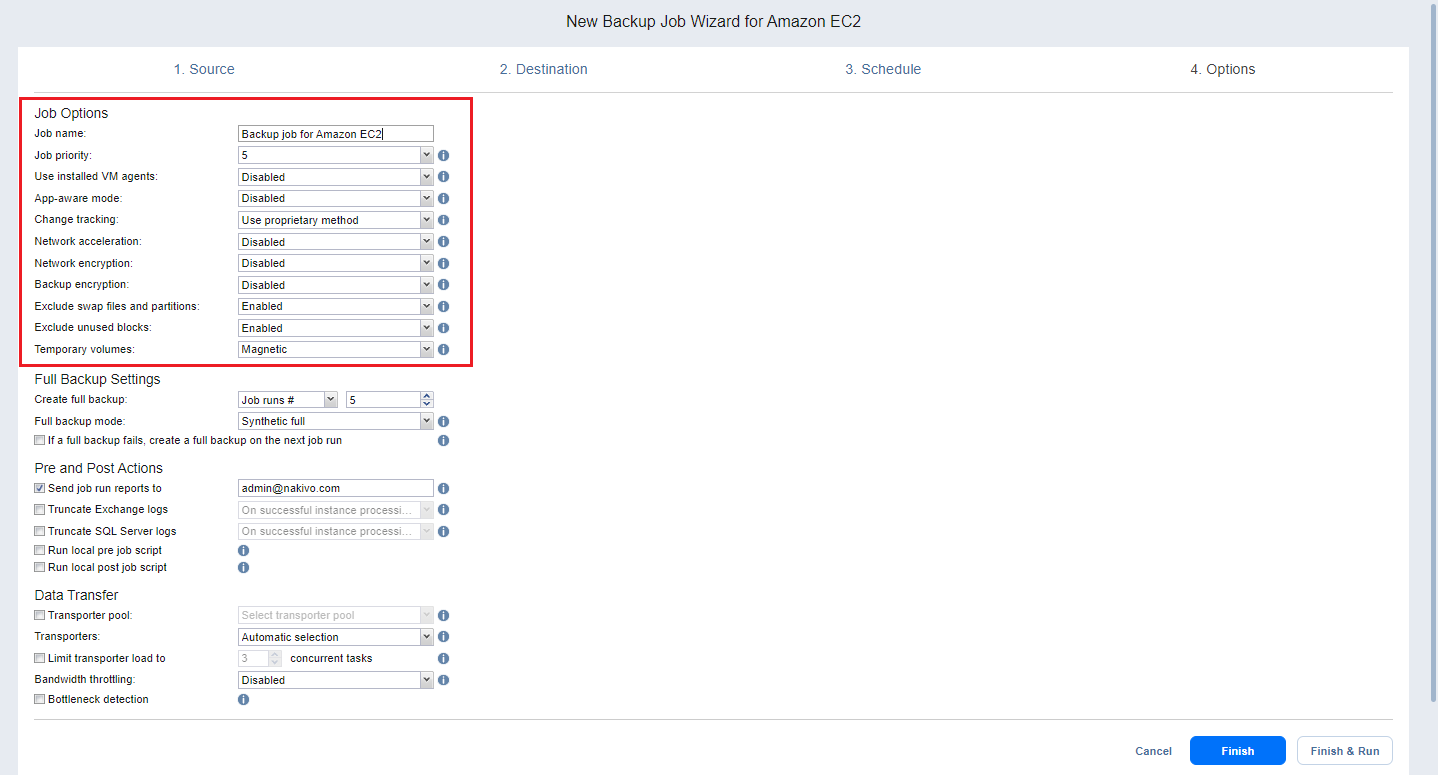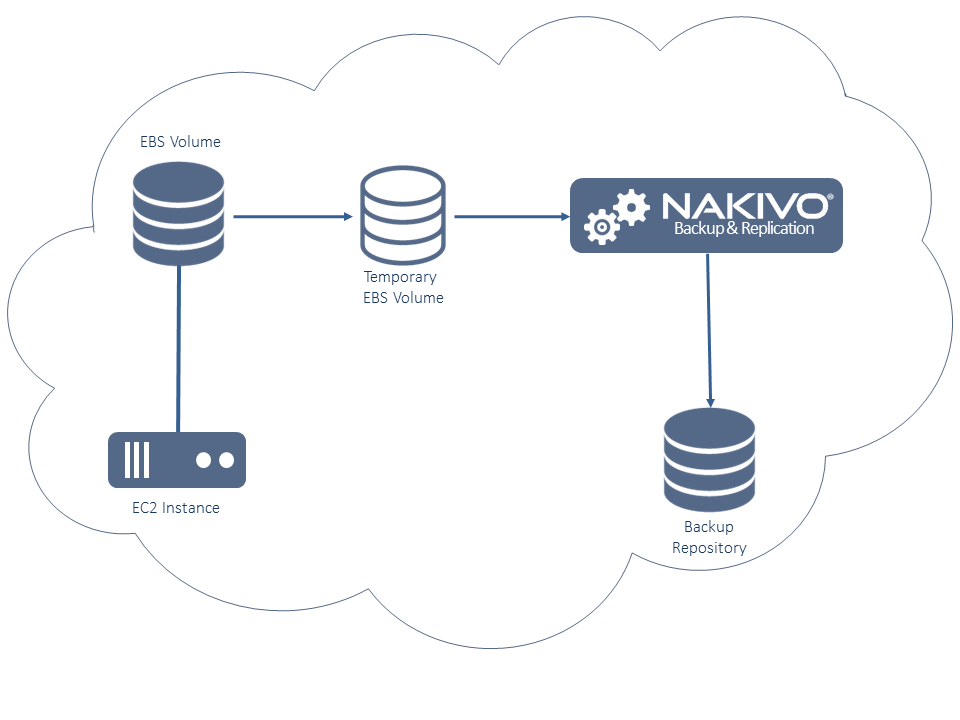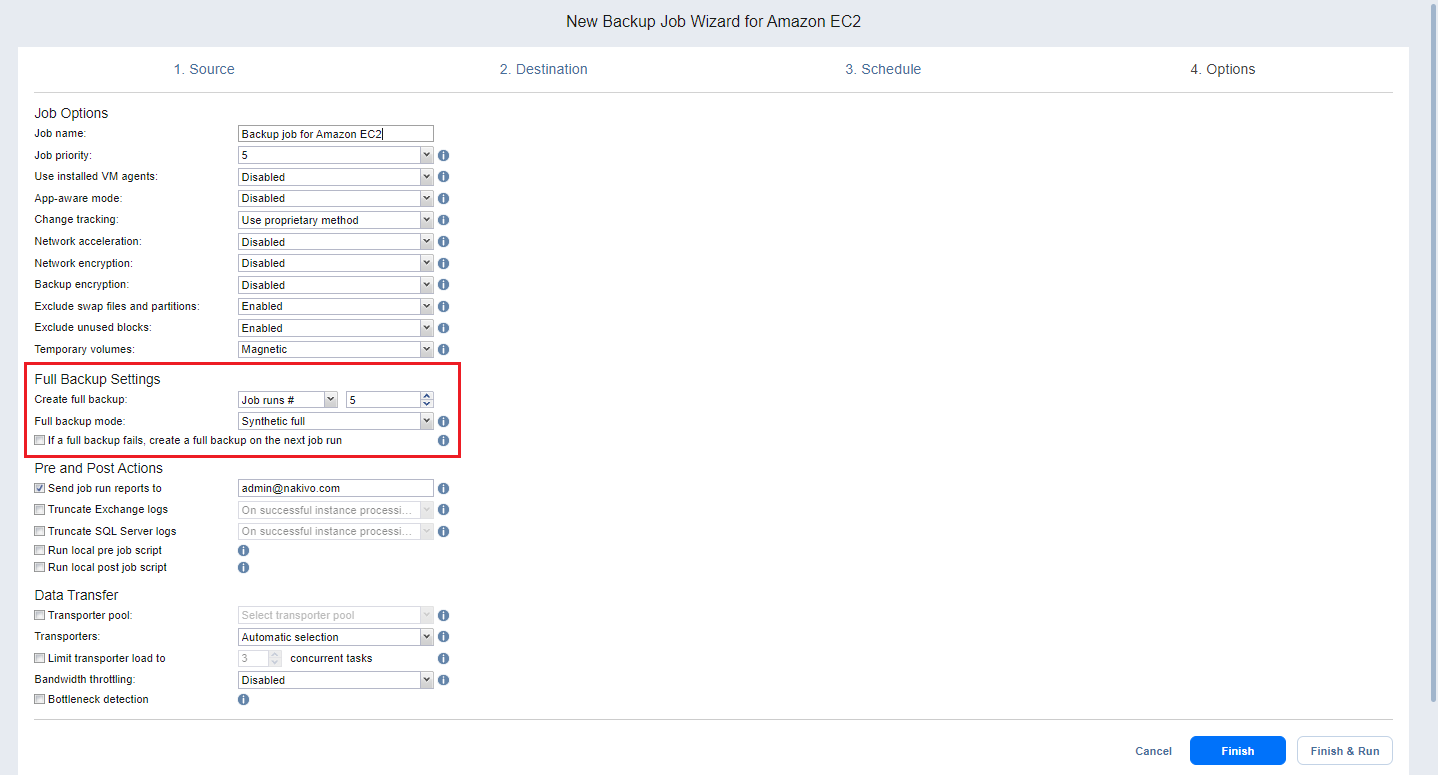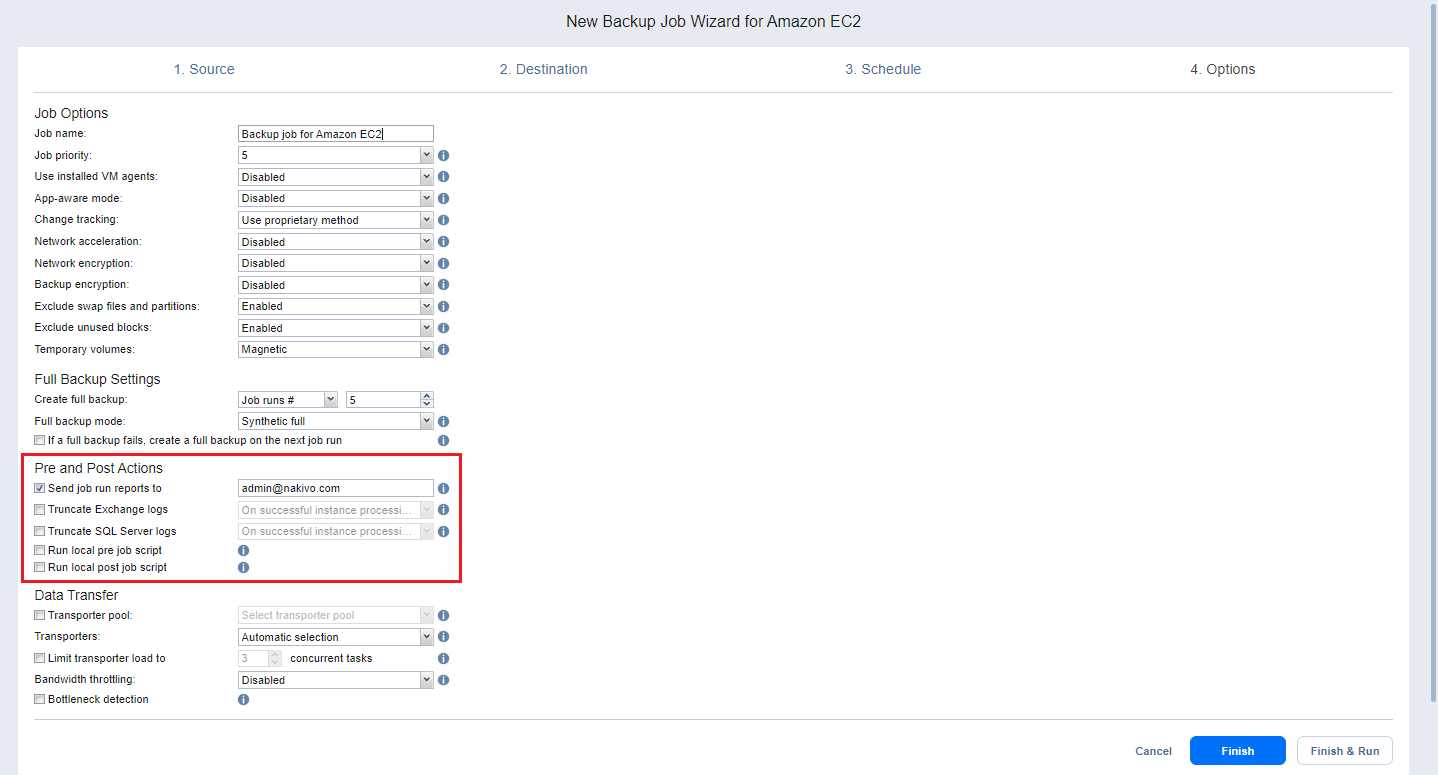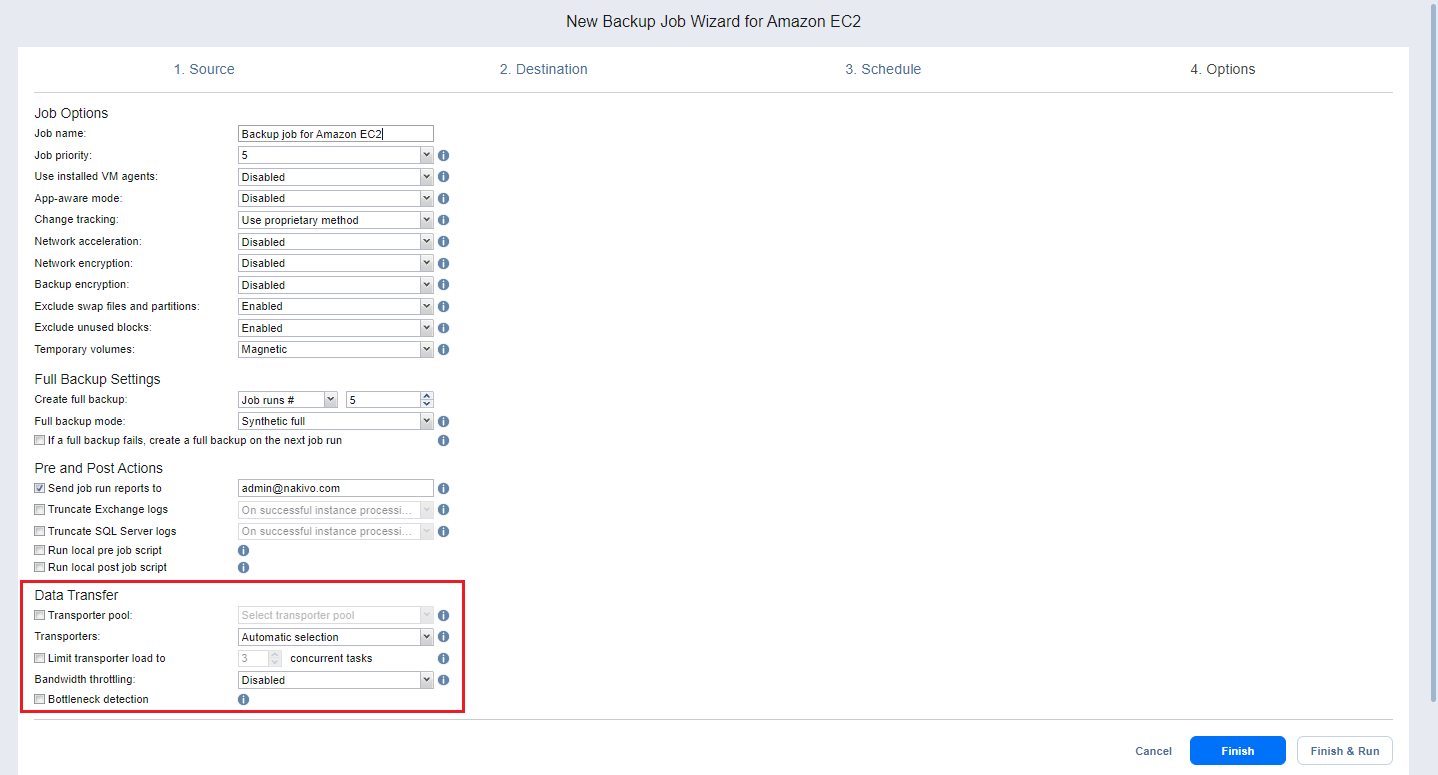Backup Job Wizard for Amazon EC2: Options
On the Options page of the wizard, you can set up various options for your Amazon EC2 backup job. Proceed as described in these sections:
Job Options
Set up general options for the job as described below.
Job Name
Enter a name for the backup job in the Job name box.
Job Priority
Select a job priority level between 1 and 5, with 1 being the highest priority. Jobs with higher priority levels are prioritized by Transporters during job processing.
Note
This option is only available in the Enterprise, Enterprise Essentials, Enterprise Plus, MSP Enterprise, and MSP Enterprise Plus editions.
Use Installed VM Agents
Enable this option if you wish to use installed VM agents for this job. Proceed as follows:
-
With the option enabled, click settings to open the Manage VM Agents pop-up menu.
-
Click Scan All to scan each instance in the job for installed agents.
-
Once the scan is complete, select the master password you wish to use for the discovered VM agents from the Select credentials drop-down list.
-
In the Certificate column, click Verify to verify the validity of an installed agent’s certificate.
For more information on setting up VM agents, see Using a VM Agent. For more information on setting up master passwords, see Managing Credentials.
Application Awareness
NAKIVO Backup & Replication provides you with the ability to create application-consistent backups of Amazon EC2 instances. The application awareness approach is different for Windows-based and Linux-based instances. Refer to the sections below for more information.
Application Awareness for Windows-based Amazon EC2 Instances
NAKIVO Backup & Replication provides application awareness for supported Windows operating systems by using Microsoft Volume Shadow Copy (VSS) service. If application awareness is enabled for a Windows-based instance, NAKIVO Backup & Replication does the following:
-
Connects to the source instance using credentials provided in the backup job wizard.
-
Automatically deploys a NAKIVO VSS driver into the instance OS.
-
With the help of the VSS driver, it creates application-consistent snapshots of the instance EBS volumes.
-
Automatically removes the VSS driver from the instance OS.
Application Awareness for Linux-based Amazon EC2 Instances
NAKIVO Backup & Replication provides you with the ability to run custom pre-freeze and post-thaw scripts on Linux-based instances in order to enable application awareness. A pre-freeze script is executed before a snapshot of an instance is taken, and the post-thaw script is executed after the snapshot has been taken.
Pre-Conditions for Application Awareness on Linux-based Instances
-
Create pre-freeze and post-thaw scripts for your Linux-based instances.
-
Make sure that SSH is enabled on the instances.
-
Place the scripts in the appropriate folders on each instance:
-
Pre-freeze:
/usr/sbin/pre-freeze-script -
Post-thaw:
/usr/sbin/post-thaw-scriptMake sure that you allow the execution of the script files.
For example:
chmod +x /usr/sbin/pre-freeze-script
-
Setting Application Awareness
Set up application awareness as follows:
-
Select one of the options from the App-aware mode drop-down list:
-
Enabled (proceed on error): If this option is selected, the instance backup will continue to run even if application awareness fails.
-
Enabled (fail on error): If this option is selected, instance backup will fail if application awareness fails.
-
Disabled: If this option is selected, application awareness will not be used for instance backup.
-
-
If the application awareness mode is enabled, specify the OS credentials that will be used to connect to instances:
-
Click the Settings link.
-
In the dialog box that opens, select a checkbox next to each instance which you would like to back up in application-aware mode.
-
Select the appropriate credentials from the drop-down list next to each selected instance.
-
Change Tracking
Select one of the options from the Change tracking drop-down list:
-
Use proprietary method: NAKIVO Backup & Replication will read the entire contents of all VM disks in order to determine what data has changed since the last job run.
-
No change tracking (always full): the application will always perform a full VM backup of all source VMs.
Network Acceleration
If this option is selected, NAKIVO Backup & Replication will use compression and traffic reduction techniques to speed up the data transfer. Select this option if you plan to back up over WAN or slow LAN links. Refer to Network Acceleration for more details.
Note
The Network acceleration option is not available if the Backup encryption option is enabled.
Network Encryption
If the Network Encryption option is enabled,, backup data is protected with AES 256 encryption while traveling over the network. Data encryption increases the backup time and CPU load on machines running Transporters. Select this option if you plan to back up over WAN without a VPN connection. For more information, refer to Encryption in Flight and at Rest.
You need at least one Transporter at the source and target sites to enable network encryption.
Backup Encryption
When enabled, backup data is protected with AES 256 block cipher encryption with a 256-bit key length. You can protect the backup file by creating a new password or selecting an existing one. For more information, refer to Enabling Backup Encryption.
Notes
This option is available only if the Disk or Tape destination type was chosen on the Destination page of the wizard.
The Backup encryption option is not available if the Network acceleration option is enabled.
If enabled, the created recovery points are encrypted.
The Backup encryption option is not displayed for a backup job where forever incremental repositories are selected as the only target repositories.
The Backup encryption option cannot be enabled if multiple targets with a mix of supported and unsupported (SaaS repositories or forever incremental repositories) repositories are selected as destinations.
It’s recommended that you enable the (AWS) Key Management Service. If KMS is enabled, all backup encryption passwords encrypted with the Key Management Service cryptographic key are available for recovery in case of product re-installation. For more information, refer to Enabling KMS.
Temporary Volumes
When you back up an EC2 instance, NAKIVO Backup & Replication creates temporary snapshots of the instance's EBS volumes, converts the snapshots into temporary EBS Volumes, and then reads the data from the temporary volumes and sends it to the backup repository.
By default, the type of temporary EBS volumes is set to "General Purpose SSD" to ensure higher performance. However, if you run backups frequently, this kind of storage may result in noticeably higher storage costs. To reduce costs, you can set the type of the temporary EBS Volumes to Magnetic disk. You can switch between those two options under the Temporary volumes drop-down list.
Exclude Swap Files and Partitions
With this option enabled, NAKIVO Backup & Replication automatically excludes swap files and partitions during the backup process.
Exclude Unused Blocks
With this option enabled, NAKIVO Backup & Replication automatically excludes unused disk blocks and blocks occupied by deleted files during processing of source objects running Windows OS. This feature allows for reducing backup storage space and object processing time.
Full Backup Settings
If the type of the Backup Repository that you selected on the Destination page is set to Incremental with full backups (Store backups in separate files option is selected), you can specify the following options:
-
Create full backup: Specify how often full backups should be created.
-
Full backup mode: Specify how the full backup should be created. You can choose one of the following options:
-
Synthetic Full: When this option is selected, NAKIVO Backup & Replication first performs an incremental backup (that is, transfers only the data that has changed since the last backup) and then transforms the available data into a full backup file. The benefits of this approach are:
-
The Synthetic Full backup is usually faster than the Active Full backup.
-
The load on the network is lower as less data is transferred.
-
The load on the source datastores running your production instances is lower.
-
-
Active Full: When this option is selected, NAKIVO Backup & Replication reads all VM data from the source datastore and transfers it to the Backup Repository.
-
-
If a full backup fails, create a full backup on the next job run: With this option selected, the next job run creates a full backup if the current job run fails to do so.
Pre and Post Actions
Email Notifications
NAKIVO Backup & Replication can send email notifications on job completion status to specified recipients. This feature complements global notifications and provides the ability to configure notifications on the per-job level.
To enable this option, configure your Email settings.
To send email notifications, do the following:
-
In the Pre and Post Actions section, select the Send job run reports to option.
-
Specify one or more email addresses in the text box. The semi-colon character should be used to separate multiple email addresses.
Truncation of Microsoft Exchange Server Transaction Logs
Microsoft Exchange Server database transaction logs record all changes to a Microsoft Exchange server database. Over time, these log files accumulate and can consume all of the available disk space, if not periodically removed. NAKIVO Backup & Replication provides an option to delete (or truncate) Microsoft Exchange Server logs on the source instances after job completion.
The transaction logs are deleted after the job is completed so that the log files are available in the instance backup. Note that the product deletes only those transaction logs which are already committed to (available in) the Microsoft Exchange database.
To set up Microsoft Exchange log truncation, do the following:
-
In the Pre and Post Action section, select the Truncate Exchange logs option.
-
In the dialog box that opens, select the checkboxes next to the instances running Microsoft Exchange and then select credentials next to each instance. These credentials will be used to log in to instances you have selected.
Truncation of Microsoft SQL Server Transaction Logs
Microsoft SQL Server database transaction logs record all changes to a Microsoft SQL Server database. Over time, these logs accumulate and can consume all of the available disk space, if not periodically removed. NAKIVO Backup & Replication provides you with the option of deleting (or truncating) Microsoft SQL Server logs on the source instances after job completion.
The transaction logs are deleted after the job is completed so that the original log records are available in the instance backup. Note that the product deletes only those transaction logs that are already committed to (available in) the Microsoft SQL Server database.
To set up Microsoft SQL log truncation, do the following:
-
In the Pre and Post Actions section, select the Truncate SQL Server logs option.
-
In the dialog box that opens, select checkboxes next to the instances running Microsoft SQL and then select credentials next to each instance. These credentials will be used to log in to instances you have selected.
Pre and Post Job Scripts
NAKIVO Backup & Replication allows you to run a script before Instance backup begins (a pre-job script) and after the backup of all Instances in the job has completed (a post-job script). The scripts can be executed only on the machine on which the Director is installed. Do the following:
Running a Pre-Job Script
To run a script before the product begins backing up Instances, do the following:
-
Place a script file on the machine on which the Director is installed.
-
In the Pre and Post Actions section, select the Run local pre job script option.
-
In the dialog box that opens, specify the following parameters:
-
Script path: Specify a local path to the script on the machine on which the Director is installed. Script interpreter should be specified.
Example (Windows): cmd.exe /c D:\script.bat
Example (Linux): bash /root/script.sh -
Job behavior: Choose either of the following job behaviors in relation to script completion:
-
Wait for the script to finish: If this option is selected, Instance backup will not be started until the script is completed.
-
Do not wait for the script to finish: If this option is selected, the product will run the script and will start backing up Instances at the same time.
-
-
Error handling: Choose either of the following job behaviors in relation to scrip failure:
-
Continue the job on script failure: If this option is selected, the job will perform Instance backup even if the script has failed.
-
Fail the job on script failure: If this option is selected and the script fails, the job will be failed and Instance backup will not be performed.
-
Running a Post-Job Script
To run a script after the product has finished backing up all Instances, do the following:
-
Place a script file on the machine on which the Director is installed.
-
In the Pre and Post Actions section, select the Run local post job script option.
-
In the dialog box that opens, specify the following parameters:
-
Script path: Specify a local path to the script on the machine on which the Director is installed. Script interpreter should be specified.
-
Example (Windows): cmd.exe /c D:\script.bat
-
Example (Linux): bash /root/script.sh
-
-
Job behavior: Choose either of the following job behaviors in relation to script completion:
-
Wait for the script to finish: If this option is selected, the job will be in the “running” state until the script is completed.
-
Do not wait for the script to finish: If this option is selected, the job will be completed even if the script execution is still in progress.
-
-
Error handling: Choose either of the following job behaviors in relation to script failure:
-
Continue the job on script failure: If this option is selected, script failure will not influence the status of the job.
-
Fail the job on script failure: If this option is selected and the script has failed, the job status will be set to “failed” even if Instance backup has been successful.
-
Data Transfer
Transporter Pool
If this option is enabled, only the transporters that belong to the selected transporter pool shall be used during the job run.
Transporters
In NAKIVO Backup & Replication, Transporters perform all of the heavy lifting: reading data from the source Instance, compressing the data, transferring the data over the network, performing data deduplication, and so on. In large and geographically distributed environments, multiple Transporters can be deployed to distribute the data protection workload, optimize network traffic, and improve data transfer speeds. Thus, if more than one Transporter is deployed for NAKIVO Backup & Replication, it is important to determine which should be used to read data from a particular source Instance (the target Transporter is always that which has been assigned to the Backup Repository).
By default, the product automatically determines which Transporter should be used to read data from the source Instance. However, you can manually specify which Transporters should be used for the job by choosing either of the following options for Transporters in the Data Transfer section:
-
Automatic selection: The product will automatically determine which Transporter should be used to retrieve data from source Instances.
-
Manual - configured for all Instances: Select this option to manually specify a single Transporter that will be used to retrieve data from all Instances.
-
Manual - configured per region: Select this option to manually set a Transporter for each Region in Amazon EC2.
The target Transporter for the backup job will always be the Transporter assigned to the Backup Repository.
Transporter Load
You can limit the maximum number of transporter tasks used by the job. By default, it is set to 3 concurrent tasks.
To change the default number of tasks, do the following:
-
In the Data Transfer section, select the Limit transporter load to checkbox.
-
Specify the number of concurrent tasks in the corresponding box.
Bandwidth Throttling
Follow the steps below to regulate the speed of data transfer over the network for your backup job:
-
For the Bandwidth throttling option, choose Enabled.
Note
If bandwidth throttling is disabled for the current job, global bandwidth rules may still apply to your job. Refer to Bandwidth Throttling for details.
-
Click the Settings link that becomes available.
-
The Job Bandwidth Rules dialog box opens displaying you the list of available rules. You have the following options:
-
Create a new bandwidth rule for your backup job:
-
Click the Create New Rule button.
-
The New Bandwidth Rule dialog box opens. Refer to the Bandwidth Throttling topic for details on creating a bandwidth rule.
-
Click Save.
-
-
Activate an existing bandwidth rule for your job. Select the checkbox to the left of the necessary bandwidth rule. To deactivate a bandwidth rule for your job, deselect the corresponding checkbox.
-
Edit a bandwidth rule. Click the Edit link for a bandwidth rule and modify it in the Edit Bandwidth Rule dialog box that opens.
-
Disable a bandwidth rule. Click the Disable link. The bandwidth rule will be disabled for all jobs.
-
Remove a bandwidth rule. Click the Remove link and then click Delete to confirm your operation.
Bottleneck detection
When the Bottleneck detection option is enabled, additional information is collected and recorded in NAKIVO Backup & Replication logs in the course of data transfer for the purpose of bottleneck detection. Check this option to enable the Bottleneck detection capability of the Transporters engaged in the job.
-
Completing the New Backup Job Wizard for Amazon EC2
Click Finish or Finish & Run to complete the job creation.
Note
If you click Finish & Run, you will have to define the scope of your job. Please refer to Running Jobs on Demand for details.
